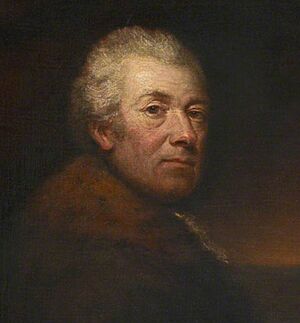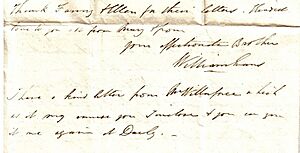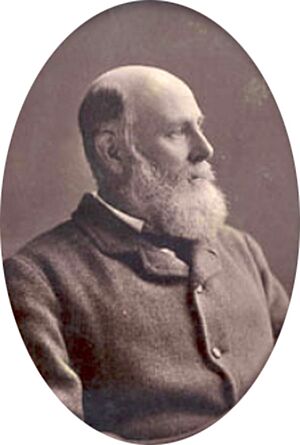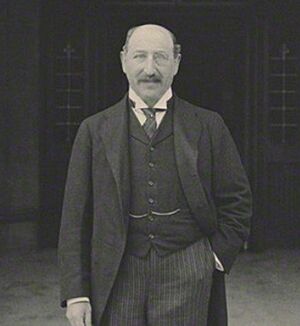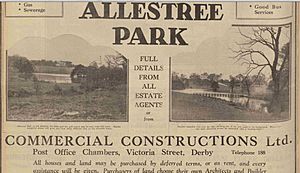Allestree Hall facts for kids
Quick facts for kids Allestree Hall |
|
|---|---|
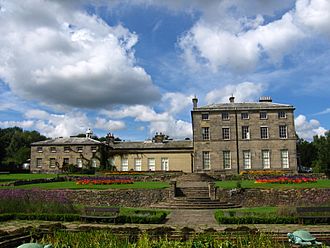
Allestree Hall
|
|
| General information | |
| Status | For Sale |
| Town or city | Allestree, Derby |
| Country | England |
| Current tenants | Derby City Council |
| Client | Bache Thornhill |
| Owner | Derby City Council |
Allestree Hall is a large house built in the 1800s, located in Allestree Park, Allestree, Derby. It's a special building, listed as Grade II*, which means it's very important historically. However, it has been empty for many years and is now on a list called the Heritage at Risk Register. This list helps protect important buildings that might be falling apart.
The Mundy family owned the land where Allestree Hall stands from 1516 until 1781. Later, the house belonged to William Evans and his son, Sir Thomas William Evans, 1st Baronet. When Sir Thomas died in 1892, he left the estate to his brother-in-law, William Gisborne.
The area around the house, known as Allestree Park, was set up in 1818. The house was started by Bache Thornhill and finished by John Giradot. It has three floors and a grand entrance with columns.
A large part of the estate was sold for building new homes in 1928. Today, the house is in a 300-acre (1.2 km2) wooded park with a lake, grassy areas, and a golf course. Derby City Council owns the park. Allestree Park is also a special place called a Local Nature Reserve, which means it's protected for its wildlife and nature.
Contents
- Who Lived Here? The Early Years
- William Evans: A Champion Against Slavery
- Sir Thomas William Evans: A Local Leader
- William Gisborne: From New Zealand to Allestree
- Sir Herbert Raphael: A Politician and Soldier
- Colonel Herbert Johnson: A Tragic End
- Allestree Hall's Recent Story
- Allestree Park: A Green Oasis
- See Also
Who Lived Here? The Early Years
In 1795, Bache Thornhill bought the land and tore down the old house that was there. He hired James Wyatt, a very famous architect, to design the Allestree Hall we see today. The plans for the house still exist. You can even find a stone in the building with the date 1802 and James Wyatt's initials, J. W., carved into it.
Bache Thornhill was born in 1747 in Derbyshire. He studied at Oxford University. In 1805, he sold Allestree Hall to John Charles Girardot.
John Charles Girardot was born in 1771. His family were French Huguenots, a group of Protestants who faced challenges in France. He lived at Allestree Hall for about 20 years. In 1824, he sold the house to William Evans.
William Evans: A Champion Against Slavery
William Evans lived at Allestree Hall for a long time, about 30 years, from 1824 until he passed away in 1856. He was born in 1788 in Derbyshire. His father was very wealthy, and William inherited a share in many businesses, including a bank, cotton mills, and lead smelting.
In 1820, he married Mary Gisborne. They had one child. William became a politician and was a close friend of William Wilberforce. He joined Wilberforce in the important fight to end slavery. Both were key members of the Anti-Slavery Society (1823–1838). There's even a letter from William Evans to his sister where he mentions getting a letter from Wilberforce.
William died at Allestree Hall in 1856 when he was 68. His only child, Thomas William Evans, inherited the property.
Sir Thomas William Evans: A Local Leader
Thomas William Evans was born at Allestree Hall in 1821. He went to Trinity College, Cambridge. After finishing his studies, he married his cousin, Mary Gisborne. They did not have any children.
He inherited his father's wealth in 1856. He became a Member of Parliament in 1857 and served for many years. He was also very active in local government. He was the first Chairman of the Derbyshire County Council and held that job until he died. He was also the Mayor of Derby in 1869 and was made a baronet (a special title) in 1887.
He died at Allestree Hall in 1892. Since he had no children, he left the Hall to his brother-in-law, William Gisborne.
William Gisborne: From New Zealand to Allestree
William Gisborne was 67 years old when he inherited Allestree Park in 1892. He was the third son of Thomas John Gisborne. When he was 22, he moved to New Zealand and became a Commissioner of Lands, which is an important government job. He worked his way up in the Civil Service. In 1869, he became a politician in the New Zealand Legislative Council, serving for 12 years.
In 1861, William married Caroline Gertrude Bridgen in Auckland. They had three daughters and one son.
In 1881, his family moved back to England to manage other family estates. In 1892, he inherited Allestree Hall. He lived there for six years and died at the Hall in 1898 at the age of 73.
After William's death, his only son, Lionel Guy Gisborne, inherited the property. Lionel lived there for a few years, but in 1902, he decided to rent it out to Sir Herbert Raphael.
Sir Herbert Raphael: A Politician and Soldier
Sir Herbert Raphael rented Allestree Hall from 1902 to 1913. He was born in 1859, the son of a very important banker. He studied law at Cambridge University. After practicing law for some years, he decided to become a politician. He was a Member of Parliament for South Derbyshire from 1906 to 1918.
In 1884, he married Rosalie Coster. They did not have any children. He owned another property in London, but he rented Allestree Hall because he wanted to live in the area he represented as a politician.
When World War I started, he joined the army as a Private in the 2nd Sportsmen's Battalion. He rose through the ranks during the war and eventually became a Major.
In 1913, Lionel Gisborne wanted to sell the Hall, so Herbert and Rosalie had to move out. He sold the property to Colonel Herbert Johnson.
Colonel Herbert Johnson: A Tragic End
Herbert Alfred Johnson was born in 1866 in Lancashire. His father owned a wire company, and Herbert became very wealthy when he and his brother took over the company after their father's death.
In 1895, he married Ethyl Barnard, an American, in New York City. They had one daughter and one son.
They bought Allestree Hall in 1913. One year later, when World War I began, Herbert joined the armed forces. He became a Colonel of the 17th Manchester Battalion. He was hurt during a battle at Montauban and was sent to a hospital in London. He recovered and returned to Allestree Hall after the war.
Sadly, in 1923, while he was in Allestree Park, he was struck by lightning during a bad thunderstorm and died. His wife, Ethyl, continued to live at the Hall until she died in 1928.
Allestree Hall's Recent Story
Around 1928, the Hall was sold to a company called Commercial Constructions Ltd. They divided up some of the land and sold it off in 1936. During World War II, the Hall was used by the National Fire Service as their main office for the county. Another report says that the Sherwood Foresters Regiment used the Hall during the war.
Derby City Council bought Allestree Hall around 1946. Two years later, they built the golf course that now surrounds the Hall.
In the 1970s, there was a plan to tear down the Hall. But in the mid-1980s, the city's museums service suggested turning the building into a natural history museum. However, by 1988, the idea for a 'Derby Nature Museum' was dropped. No other use was found for the building, and it continued to get worse.
The Hall was added to the English Heritage At Risk Register 2010. This report said that the inside of the building was in poor condition. The city and English Heritage are still looking for a good plan to fix up and reuse the building.
Allestree Park: A Green Oasis
Allestree Hall is located inside Allestree Park. At 129 hectares (about 319 acres), it's the biggest public green space in Derby. Derby City Council has owned it since 1947. Allestree Park has lots of trees, including very old ones, large grassy areas, a lake, marshland, and hedges. All these different areas are important habitats for wildlife, helping with the Lowland Derbyshire Biodiversity Action Plan (a plan to protect local plants and animals).
In 2002, a large part of Allestree Park (87.83 hectares) was named a Local Nature Reserve (LNR). It's the biggest LNR in Derbyshire! Special animals and plants found here include the harvest mouse, brown hare, white-letter hairstreak butterfly, English elm trees, adder's tongue fern, and moonwort plants. The park is managed by a group that includes the City Council, the Friends of Allestree Park, and The Conservation Volunteers.
A nine-hole golf course was built in 1947, the same year the Council bought the park. In 1955, it was made into an eighteen-hole course. Allestree Park Golf Course is known as "one of the most picturesque courses in the Midlands." The golf course is not part of the Local Nature Reserve. Other fun things to do in Allestree Park include an orienteering course (like a treasure hunt with a map), nature trails, and fishing in the park lake. For many years, there were animal enclosures near the Hall that were very popular, especially with young children.
In 2008, the Council suggested removing the animals and their enclosures to save money. Many local people and politicians were against this idea, so it was put on hold. However, due to more money cuts, the animals were finally moved in 2013.
Park's Ground and Hills
What's Under the Ground?
Most of Allestree Park sits on layers of Carboniferous sandstone and shale, as well as glacial drift (rock and soil left behind by glaciers). The large wooded area, called Big Wood, is on top of Sherwood sandstones. In some places, these sandstones have been dug up for sand. These areas are now protected as Regionally Important Geological Sites.
How High is the Park?
Allestree Park slopes downwards from west to east, and from north to south. The steepest parts are on the western edge of the Park. At its northernmost point, the ground reaches 140 meters (about 460 feet) high. This is the highest point in the city of Derby!
Old Farm Fields: Ridge and Furrow
Some of the grassy areas and even parts of the woodland in Allestree Park have wavy patterns on the ground. These are called ridge and furrow. They are visible signs of how people farmed and ploughed the land way back in the Middle Ages. This type of farming stopped in 1763 when the land was taken by the Enclosure Act and given to the Mundy families. The strips of land would have been used to grow wheat for bread and barley for ale. The fact that these wavy patterns are still there shows that the land hasn't been ploughed since those old days.
See Also
- Allestree


